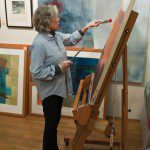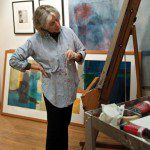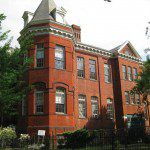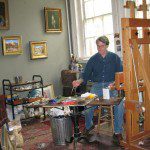Behind the Walls of Jackson Art Center
By • July 26, 2011 0 2965
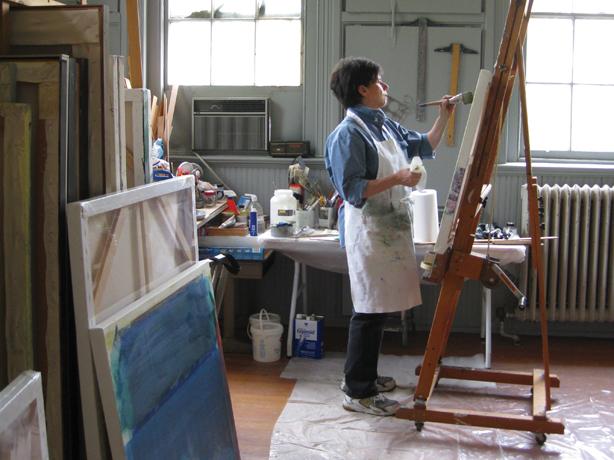
Since the late 1960s, the Jackson Arts Center has been a unique haven for artists within the city and Georgetown neighborhood. Without the studio space available in many cities around the country, Washington artists often find themselves without suitable accommodations, working out of their homes or group-leased office space. But when the Jackson School closed its doors as a public elementary school, a colony of artists took control of the Victorian schoolhouse and transformed its spacious rooms with tall, wide windows into ideal studio space for artists of all kinds. Not as commercialized as the Torpedo Factory in Alexandria, VA, the Jackson Art Center is an ideal retreat for serious artists who want to focus on their craft and contribute to the community’s culture. Over forty years later its vision has remained steadfast and the artwork enriching.
The Jackson Arts Center, 3050 R St. NW, will be holding their Open House on Sunday December 5, from 12 to 5 p.m. The artists will be in their studios ready to discuss their work, and some is even for sale. And with the holidays just around the corner…you get the idea. The work will speak for itself.
I sat down with Simma Liebman, a painter and president of the Jackson Arts Center, for a Q&A about the history of the Jackson Art Center and its importance within the community:
What is the history of the Jackson Arts Center? How long has it been with the community?
The Jackson School was one of several DC public elementary schools in Georgetown, until the late 1960s when enrollment dwindled. The 115-year-old building stood vacant at the corner of R Street and Avon Lane for close to ten years when a group of local artists inquired about renting the building for use as studio space. DC Public Schools agreed to lease the building to A.Salon, a group of independent artists, as well as to the Corcoran School of Art.
After several years, the Corcoran moved out and leased a building at Wisconsin Avenue and Reservoir Road. DCPS allowed A.Salon to assume the full lease for Jackson. When word got out among DC artists that studio space was available in an old public school building, we were inundated with inquiries. Within a month, our A.Salon group grew from five to 30 artists.
We are currently operating under a 15-year lease with DCPS and have reorganized as Jackson Art Center. There are now more than 45 artists using the building.
Tell me about the space and what you’ve done with it.
Jackson was built in the same style as many Georgetown public schools: three floors, four large classrooms per floor, each with a narrow “coat room” outside of it, with bathrooms in the basement, wide staircases, and no elevators. When we moved in, we found quite a few reminders that the building had been designed for young children—rows of coat hooks three feet above the floor, small toilets and sinks and so on.
The building retains many features that show its age. There is a massive boiler system (complete with coal bin, although now we use gas) that provides heat to radiators that hiss and clank as steam moves up in them; a predecessor to today’s fire alarm systems whereby if there’s a fire or smoke emergency in the boiler room, a stream of water gushes out of a first floor pipe to the sidewalk in front of the building, to alert any passersby to get help; and electrical wiring designed for light bulbs only.
But the space is fabulous for artists. High ceilings, large windows, lots of light. By dividing the large classrooms into as many as four spaces each, we can now accommodate 45 artists, with lots of common areas for members to display their work.
When we moved in, about 25 years ago, DCPS provided some maintenance to the building, but our current lease requires that we maintain the building ourselves. So far, with rent credits provided by DCPS, we have been able to repair the roof, install a new boiler, repair an outside wall and perform some mold abatement.
How long have you personally been with the center?
I joined A.Salon in 1988. At that time, the Corcoran was occupying most of the classroom space. At first I shared a basement studio with another painter, but when the Corcoran moved out in 1990, we both moved up to the top floor.
We are basically a volunteer organization. Since I’ve held a studio in the building since 1988, I’ve been involved in the organization of the membership in various ways. We established a seven-member board as well as three operating officers. I am the current president.
What was it like when you first got here? Has it changed?
Jackson is a registered historic building. With its position on R Street across from Montrose Park, it has great views from every window.
When I moved in, the Corcoran had already made some improvements in some classrooms: wood floors, updated wiring for computers. But basically, it was an old building with great windows and light. In the early 90’s, the city performed some asbestos removal, and, as I mentioned before, over the years we have had to repair the roof and gutters. Physically, the building is showing its age. But we are determined to preserve it as best we can.
What makes Jackson Art Center such a commodity to the city, from the perspective of the artist as well as the patron/public?
There is a dearth of affordable studio space in this city. There are no old “factory” buildings like you find in New York or Philadelphia that can be easily converted to studios. Many area artists tend to work either at home or in small retail spaces scattered around the city. We are very grateful that DC has allowed us to convert the Jackson School building into shared studio space, and we try to take every opportunity to reciprocate by being good neighbors and opening up our doors to the community.
Are all the artists members of the Georgetown community?
21 Jackson artists live in Georgetown. Most of the rest live elsewhere in DC and a few in Virginia and Maryland.
Has the city been helpful in supporting and maintaining your efforts? Is there anything you would like to see change?
We are most appreciative of the city’s support. Likewise, we hope to continue to be able to offer studio space to DC artists as well as preserve this historic building. The only change we would like to see is no change.
Do you guys often involve the community with yourselves and what you’re doing?
Part of our mission is community involvement. While our building is accessible only by members, we open our doors twice a year—in May and December—for the public to see the building and visit artists in their studios. Periodically, we hold “Art Talks,” inviting the public to attend a lecture or presentation.
What are your hopes for the future of Jackson Art Center?
It seems that in the 22 years I’ve had a studio at Jackson, the consistent concern has been for our future in the building. Since there are really no art studio buildings in DC like the Torpedo Factory in Alexandria, it would be terrific if the city and Georgetown could help establish Jackson as a permanent art building. I believe the neighborhood would appreciate having the building used for purposes other than another condominium. And there are endless opportunities for us to interact with the community, such as providing meeting/event space, art classes and lectures.
Any projects in the works now?
Yes! Our Open Studios will be held on Sunday, December 5, from 12 to 5 pm. As always we invite everyone to stop by and see what we’re doing. Most of our members will be there in their studios, happy to talk to you about their work and, of course, to sell you a piece or two. It’s a fun afternoon with music and refreshments. And children are welcome, too.
And always, our biggest project is preserving the Jackson building. Now that our roof is fixed, we need to address the windows, which are in bad shape and in desperate need of replacement. And there are a lot of them. We’re presently in negotiations with the DC Realty Office to do this major repair. After that, we hope to repaint the common interior spaces.
Visit the Jackson Art Center online for more information.
- Yelp
- Yelp
- Simma Liebman, acting president of Jackson Art Center, painting in her studio | Karen Ruckman

